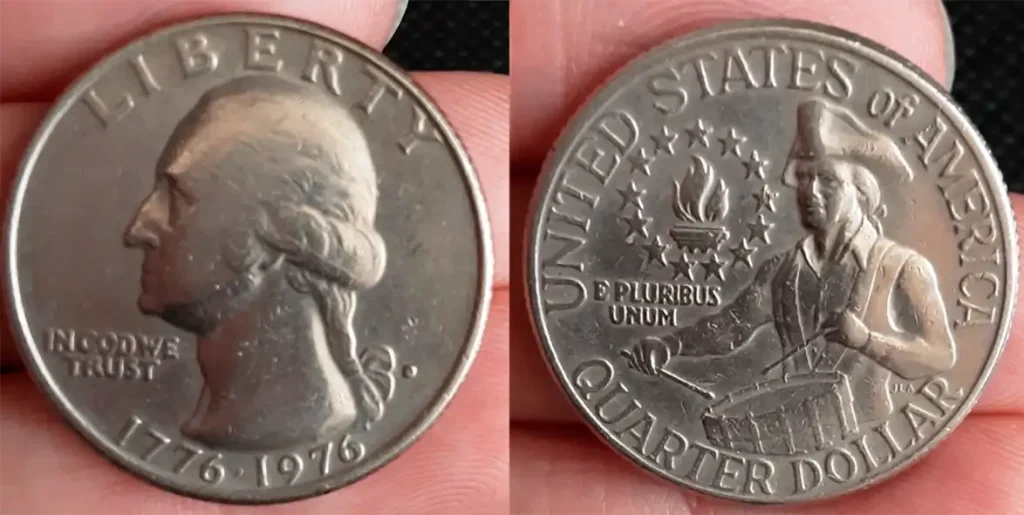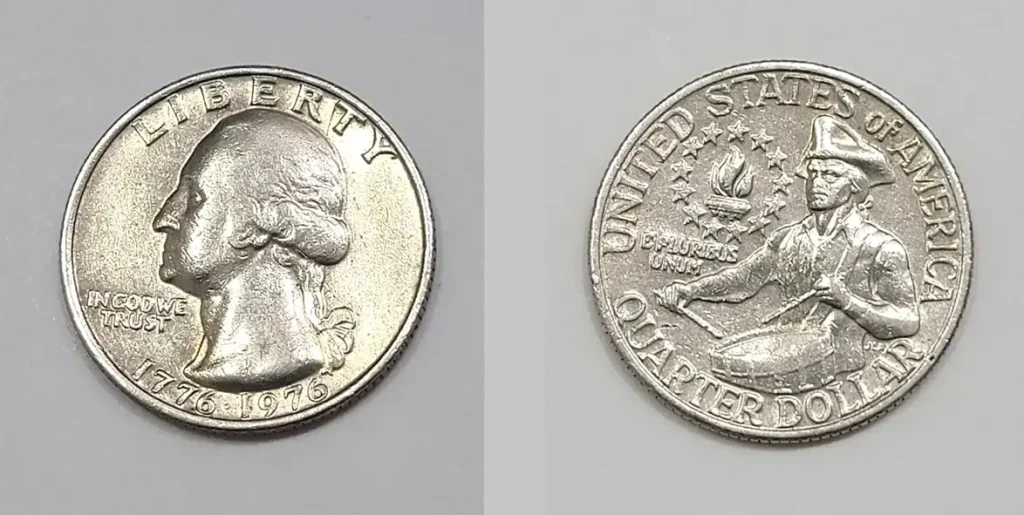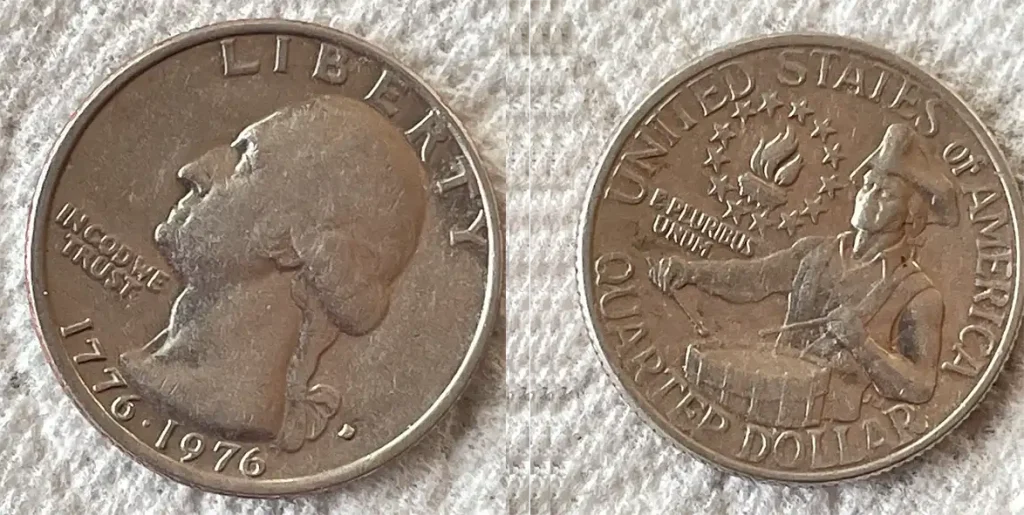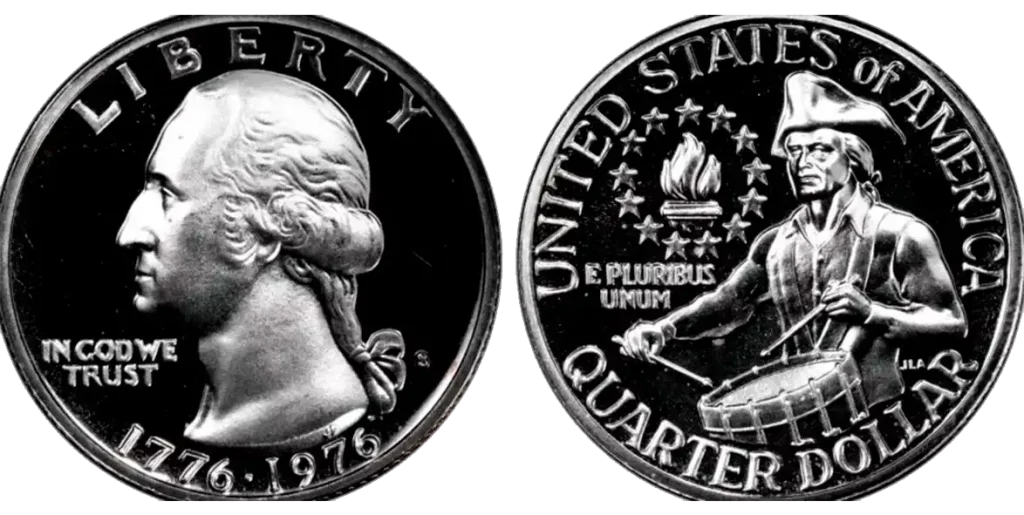
Bill Johnson
About the Author
He is a historian by training, specializing in 20th–century American culture. His interest in bicentennial quarters was born out of a desire to better understand the spirit and mood of 1976, the era of the United States bicentennial celebration.
Bull considers coins not just as collectibles, but as artifacts reflecting the political and social processes of his time. He spends a lot of time in the archives, studying documents and the press of those years in order to contextualize the history of each coin.
Unlike many numismatists who focus on rarity and value, Bill is more interested in the symbolism and historical significance of each design element of the bicentennial quarters.
Connect with Bill:



Introduction
So, here is the fascinating world of bicentennial quarters, coins issued in 1976 in honor of the bicentennial of the United States of America.
These coins are not just a part of history, they are real treasures for collectors and numismatists.
- We will delve into their history, reveal their significance for the market, and learn about the different types and circulations.
Are you ready to find out what influences bicentenial quarter value and why these coins still attract the attention of collectors around the world?
Bicentennial Quarter Types & Mintage
- The 1976 bicentenial quarter coin, issued in honor of the bicentennial of the independence of the United States of America, has become not just a commemorative badge, but also a subject of keen interest to numismatists and collectors.
- Despite their apparent simplicity, there are two main types of these quarters, which differ radically both in metal composition and in circulation.
- These differences directly affect their collectible value and popularity.
Clad Quarters
The bulk of the bicentennial quarters were minted using a copper-nickel coating.
These coins, intended for everyday circulation, have the following composition: 91.67% copper and 8.33% nickel.
Visually, they look like ordinary coins, but a close examination shows that the minting was carried out at three different mints, each of which contributed to the total volume of issued copies.
Mint Marks
- No mint mark = Philadelphia
- As one of the oldest and largest mints in the United States, Philadelphia has made a major contribution to the circulation of bicentennial quarters.
- A huge number of coins – more than 809 million copies – were minted here. The absence of a mint mark is a characteristic feature of these quarters.
- They were intended for wide distribution and became an integral part of the circulation of those years.
- “D” = Denver
- The Denver Mint has also been actively involved in the production of these commemorative coins.
- His contribution of approximately 860 million copies is almost comparable to Philadelphia.
- A distinctive feature of the coins minted in Denver is the presence of the letter “D” under the bust of Washington on the obverse.
- “S” = San Francisco
- Unlike the previous two, San Francisco did not mass produce bicentennial quarters for circulation.
- Only Proof copies were minted here.
- These coins are distinguished by their high quality minting, mirrored surface and are designed for collectible sets and collectors who appreciate impeccable workmanship.
- Their circulation is, of course, significantly less than that of coins intended for circulation.
Silver Quarters
These coins, containing 40% silver and 60% copper, are distinguished not only by their precious metal, but also by their rarity.
The Rare bicentenial quarter is almost impossible to find in ordinary circulation.
They were not produced for everyday use. Instead, they were intended exclusively for collectors and were included in special sets and trial editions.
Only found in:
- The total circulation of the silver bicentennial quarters is estimated at about 11 million copies.
- This number includes both Proof coins, which are characterized by high quality minting, and coins designed for Uncirculated collectible sets.
- These coins represent significant collectible value due to their composition, limited edition, and commemorative issue status.
Bicentennial Quarter Value Chart (2024 Prices)
| Coin type | Condition | Price |
| Copper-Nickel | Bad | $0.25 |
| Good | $0.50-1 | |
| Excellent | $1-3 | |
| UNC | $3-7 | |
| Copper-Nickel (proof) | Any | $5-15 |
| Silver | Good | $10-20 |
| Silver | Proof or UNC | $20-50+ |
Rare & Valuable Bicentennial Quarter Errors
These bicentenial quarter errors can significantly increase the value of a coin, turning it from an ordinary copy into a real rarity. We offer you a detailed analysis of the most well-known and sought-after errors, as well as recommendations for their identification.
1976 No-S Proof Quarter

This error is one of the rarest and most valuable copies among the bicentennial quarters. In normal operation, all Proof coins minted at the San Francisco Mint are required to have the mint mark “S”, clearly indicating the place of their production.
However, as a result of a production failure, a small batch of coins was released without this mark, which made them extremely popular among collectors.
- The number of known and confirmed instances of this error is extremely limited.
- Numismatists all over the world are eager to get this rare specimen into their collections.
- Copies certified by reputable organizations such as PCGS or NGC are of the greatest value because their authenticity is beyond doubt.
- The price of certified copies can exceed $15,000 and continues to grow over time. Discovering bicentenial quarter no mint mark is a rare piece of luck and a great investment.
Identification Features:
- Carefully inspect the area of the coin where the mint mark should be located (usually under the bust of Washington).
- Make sure that it is completely absent.
- Check the overall quality of the coinage.
- The trial coins feature a high level of detail and a mirrored surface.
Doubled Die Obverse

A “Double Die” type error occurs during the stamp manufacturing process when the image on it (in this case, on the obverse of the coin) is re-applied, which leads to its displacement or bifurcation.
This creates the characteristic “double image” effect on the coin.
Locations Of The Double Image:
- “LIBERTY” label: Inspect this label especially carefully, as it is often subject to the DDO error.
- The inscription “IN GOD WE TRUST“: Check if there is any bifurcation of letters in this inscription.
- Date (1776-1976) distortions may also indicate the presence of DDO.
Factors Affecting the Price:
- The more pronounced the bifurcation of the image, the higher the value of the coin.
- The condition of the coin also plays an important role. Well-preserved specimens are valued higher.
- Some types of DDO are rarer than others, which is also reflected in their price.
- The price of coins with DDO can range from $50 to $1,000 and above, depending on the above factors.
Off-Center Strike

This error occurs when the stamp applying the image to the coin is offset relative to the center of the blank.
As a result, part of the image is “cropped” or goes beyond the coin circle.
This is an important defect that can affect how much is a bicentenial quarter worth.
How to identify?
Carefully examine the coin. If the image is shifted to the side and part of it is missing, this is a sign of an Off-Center Strike.
Price
- The greater the offset, the higher the value of the bicentenial quarter with the offset stroke.
- Coins with an offset of more than 30% (that is, most of the image is missing) are valued significantly higher.
- Depending on the degree of bias, the price can range from $10 to $500 and above. Particularly spectacular and rare specimens can cost even more.
40% Silver Quarters

It is important to remember that they were issued only by the San Francisco Mint (“S”) and were not intended for widespread circulation.
How to distinguish from the usual ones?
- Weight: A silver quarter should weigh 5.75 grams, while a regular copper-nickel quarter weighs 5.67 grams. The difference is insignificant, but noticeable when using accurate scales.
- Magnetic Properties: The silver quarter has no magnetic properties, while ordinary copper-nickel quarters are slightly magnetic.
The mint mark “S” must be clearly visible.
Price
The price of a silver bicentennial quarter usually ranges from $3 to $20, depending on the condition of the coin. The cost is determined mainly by the silver content.
How to Identify a Valuable Bicentennial Quarter
Check the Mint Mark
The mint mark (if any) is located on the obverse (obverse) of the coin, under the bust of George Washington.
No mint mark = Philadelphia (common)
If there is no letter under the bust of Washington, it means that the coin was minted in Philadelphia.
“D” = Denver (common)
Means that the coin was minted in Denver.
“S” = San Francisco (proof or silver)
Means that the coin was minted in San Francisco.
Look for Errors
Doubled lettering/numbers (use a 10x magnifier)
Examine the inscriptions “LIBERTY” and “IN GOD WE TRUST”, as well as the date (1776-1976) using a magnifying glass. Look for signs of bifurcation or displacement of letters and numbers.
Partial or misaligned designs (off-center strikes)
Inspect the coin to make sure that the image is centered. If part of the image is missing or extends beyond the coin circle, it may be a misaligned bump.
Missing “S” mint mark (extremely rare)
If a coin looks like a trial one (high quality minting, mirrored surface), but it lacks the mint’s “S” mark, it may be an extremely valuable specimen. This applies only to trial coins.
Test for Silver (S-Mint Only)
This check is only valid for coins minted in San Francisco.
Weigh it
Use an accurate scale to weigh the coin. The silver quarter should weigh about 5.75 grams, while the regular one weighs 5.67 grams.
Magnet test
Hold the coin up to the magnet. An ordinary copper-nickel quarter will be slightly attracted, but a silver quarter will not.
FAQ
How can I tell if my Bicentennial quarter is silver?
- Weight: A silver coin (minted in San Francisco – “S”) weighs 5.75 grams, while a regular one weighs 5.67 grams.
- Magnet: A silver coin is not magnetic, but a regular one is slightly.
This check is only relevant for coins with the mint mark “S”.
What’s the rarest Bicentennial quarter?
1976 Proof Quarter without mint mark (“S”). This is an extremely rare mistake, the price of which can exceed $15,000.
Should I clean my Bicentennial quarter?
Absolutely not! Cleaning can damage the coin and significantly reduce its value to collectors. It is better to leave it in the state it is in.
Are there any valuable errors on Bicentennial quarters?
Yes, there are several:
- The absence of the mint mark (“S”) on the trial coins.
- Double obverse stamp (DDO).
- Offset strike (Off-Center Strike).
Why were Bicentennial quarters made in 1975 and 1976?
The 1975 and 1976 coins have the double date “1776-1976” to mark the bicentennial of U.S. independence. The coin’s design was released in 1975 and continued into 1976.
Are proof Bicentennial quarters valuable?
Yes, trial bicentennial quarters (especially in excellent condition and with original packaging) are more appreciated than regular ones. Of particular value are the copies without the mint mark “S”.
How many Bicentennial quarters were made?
Billions of coins were minted. The exact numbers for each mint (Philadelphia, Denver, San Francisco) are listed in the previous answers.